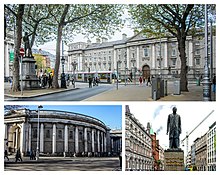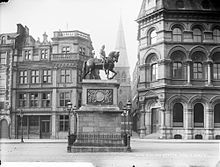College Green, Dublin
 Clockwise from top: Trinity College Dublin as seen from College Green; the Thomas Davis statue; Bank of Ireland, College Green | |||
 | |||
| Native name | Faiche an Choláiste (Irish) | ||
|---|---|---|---|
| Namesake | Trinity College Dublin | ||
| Length | 260 m (850 ft) | ||
| Width | 38 metres (125 ft) | ||
| Location | Dublin, Ireland | ||
| Postal code | D02 | ||
| Coordinates | 53°20′40″N 6°15′36″W / 53.34444°N 6.26000°WCoordinates: 53°20′40″N 6°15′36″W / 53.34444°N 6.26000°W | ||
| west end | Dame Street | ||
| east end | Trinity College, Westmoreland Street, College Street | ||
| Other | |||
| Known for | Trinity College, restaurants, nightclubs, statues, | ||
College Green (Irish: Faiche an Choláiste) is a three-sided plaza in the centre of Dublin, Ireland. On its northern side is the Bank of Ireland building, which until 1800 was Ireland's Parliament House. To its east stands Trinity College Dublin. To its south stands a series of 19th-century buildings that are mostly banks.
Streets leading onto College Green are Dame Street to the west, Grafton Street to the south, and Westmoreland Street to the north. College Green has been used as an assembly point for major political rallies. In the mid-1990s, United States President Bill Clinton addressed a crowd during his visit to Ireland. President Barack Obama also spoke at the site in a major address during his visit in May 2011.[1]
History and layout[]

The area was once known as Hoggen Green and named after the nunnery of Blessed Virgin Mary del Hogges constructed at this location in 1156 by Diarmaid mac Murchadha.[2] The name "Hoggen" derives from the Old Norse word haugr meaning mound, or barrow. The cemetery at College Green consisted of several burial mounds, which are thought to have contained the remains of some of the Norse kings of Dublin.[3]
Between Church Lane and Suffolk Street the Norse had their Thing, an assembly and meeting-place, which was still to be seen in the 17th century. All along College Green, called Hoggen Green by the English, lay their barrows.[4] Hoggen gave its name to the convent of St Mary de Hogges, which stood roughly where the Bank of Ireland is now and was a major landowner in the area until the Reformation. Originally laid out as a triangular green, it now a rough trapezoid. The site has been historically used in celebration, with newly appointed Viceroys of Ireland being welcomed on the street.[5]
Trinity College was founded on the street's east side in 1592. The west front's facade was designed by Theodore Jacobsen and added in 1751. Several public monuments stand in College Green, including a 19th-century statue facing the college of old Irish Parliament member Henry Grattan, designed by John Henry Foley.[2]

A statue of King William III of England on horseback was constructed in the centre of College Green in 1701 by Grinling Gibbons, which features in James Joyce's story The Dead. The statue was attacked and defaced numerous times through the 18th, 19th and 20th centuries, leading to many repairs.[6][7] It was eventually taken down after 277 years when it was badly damaged in an explosion on 11 November 1928, Armistice Day,[8] with the head having been stolen in 1929. The area was the temporary site of an air raid shelter during World War II. The fountain, by Edward Delaney, features four figures with trumpets which represent the four provinces of Ireland.[6]
In 1966, a statue of the poet and nationalist Thomas Davis was constructed in the centre of College Green, to mark the fiftieth anniversary of the Easter Rising. The design includes a fountain designed by Edward Delaney.[9]
Architecture[]

Chichester House was constructed by Arthur Chichester, 1st Baron Chichester in the early 17th century. It was subsequently adapted for the Irish Parliament around 1670, and replaced by a new Parliament House in 1729, designed by Edward Lovett Pearce. It was later enlarged by James Gandon in 1787 and between 1804–08. The site is now the Bank of Ireland.[2][10]
Daly's Club, a gambling house and club founded by Patrick Daly in 1750, moved to the space on College Green between Foster Place and Anglesea Street at numbers 2–5 in 1769. It closed in 1823 and the centre portion is now taken up by shops.[2]
Number 6-8 was formerly the site of the Jury's Hotel. It opened in 1839 as a commercial lodging house, and was rebuilt in 1859 and 1882. The premises was sold when Jury's relocated to Ballsbridge. The contents were auctioned, with the ornate mahogany bar sold to a buyer in Zurich. The site was bought by Patrick Gallagher in July 1979, who demolished the hotel in 1980 and built a granite-clad office block designed by Burke-Kennedy Doyle and Partners in its place. It is now occupied by Blooms Hotel.[11][9]
The Ulster Bank headquarters on College Green was built in the late 1970s. Despite objections from groups like the Dublin Civic Group, a collection of mostly Victorian buildings which faced onto College Green, and Church Lane were demolished in 1976 to make way for the new development. The high-domed Victorian façade on College Green was kept, but the interior was entirely remodelled.[12]
Guinness Mahon moved from to numbers 16–17 in 1854. The current building was constructed in 1931.[9]
Politics[]

College Green is commemorated in Francis Wheatley's painting Dublin Volunteers on College Green, which shows the Irish Volunteers demonstrating for independence on 4 November 1779.[13]
Bill Clinton, the President of the United States visited Dublin in December 1995 and gave speech in College Green to 80,000 people.[14] In May 2011, President Barack Obama gave a speech at College Green in front of 100,000. During the speech, he praised Ireland for its economic opportunities, and said he was proud of his Moneygall heritage.[15]
Traffic restriction[]
Since July 2009, College Green, during peak times on working days, has been accessible only to pedestrians, buses, taxis and cyclists.[16]
In 2016, plans were published for College Green to be fully pedestrianised, apart from a public-transport lane along the Trinity College side, to create a large public space in front of the Bank of Ireland.[17] The plans drew several protests from store owners, taxi drivers and bus operators.[18] In October 2018 An Bord Pleanála, the state planning agency rejected the plan.[19][20] The Green Party-led Dublin City Council banned traffic for three Sundays in summer 2019 in order to test the feasibility of further traffic restrictions.[21][22]
See also[]
- Statues in Dublin
- List of streets and squares in Dublin
- Dublin College Green (UK Parliament constituency)
References[]
Notes[]
- ^ Henry McDonald (23 May 2011). "Barack Obama cuts short Ireland visit after concerns over volcanic ash cloud". The Guardian. Archived from the original on 30 September 2013. Retrieved 23 May 2011.
- ^ a b c d Bennett 2005, p. 48.
- ^ "Hoggen Green ("Vikings in Dublin or Dyflin as they called it". Robert O'Connor. Viking Network)". Archived from the original on 2009-04-11. Retrieved 2009-12-04.
- ^ "Scandinavian Relations With Ireland During the Viking Period (A. Walsh, author. Dublin: The Talbot Press Limited. 1922)". Archived from the original on 2011-02-23. Retrieved 2010-03-29.
- ^ Casey 2005, p. 377.
- ^ a b Doherty, Neal (2015). The complete guide to the statues and sculptures of Dublin City. Dublin. pp. 73–74. ISBN 978-1-909895-72-0. OCLC 907195579.
- ^ "Statue of King William III". Dublin City Council. 2019-05-02. Archived from the original on 2021-06-05. Retrieved 2021-01-27.
- ^ "Equestrian statue of King William III, outside the Bank of Ireland, Dublin". The William Henry Fox Talbot Catalogue Raisonné. Archived from the original on 2021-01-22. Retrieved 2021-01-27.
- ^ a b c Bennett 2005, p. 49.
- ^ Casey 2005, pp. 377, 380.
- ^ McDonald 1985, p. 265.
- ^ McDonald 1985, p. 118.
- ^ Higgins, Padhraig (2010). A Nation of Politicians. University of Wisconsin Press. p. 178. ISBN 978-0-299-23333-4.
- ^ "The Clintons At College Green". RTE. Archived from the original on 29 April 2021. Retrieved 17 March 2021.
- ^ Carty, Ed; Stack, Sarah (23 May 2011). "Obama of the 'Moneygall' Obamas wows thousands in College Green". Irish Independent. Retrieved 16 March 2021.
{{cite news}}: CS1 maint: url-status (link) - ^ "Change to College Green traffic restrictions". 18 November 2009. Retrieved 20 December 2016.
- ^ "College Green pedestrianisation plans to go before An Bord Pleanála". 4 October 2016. Archived from the original on 5 October 2016. Retrieved 20 December 2016.
- ^ "Reclaiming College Green". Irish Times. 20 March 2018. Archived from the original on 9 November 2020. Retrieved 2 June 2021.
- ^ Olivia Kelly (18 October 2018). "College Green plaza plans are 'dead', council chief claims". Irish Times. Archived from the original on 18 October 2018. Retrieved 18 October 2018.
- ^ Kilraine, John (17 October 2018). "Pedestrian plaza plans for Dublin's College Green refused". RTÉ. Archived from the original on 24 September 2019. Retrieved 24 September 2019.
- ^ "College Green traffic ban for three summer Sundays to test plaza plan". The Irish Times. June 23, 2019. Archived from the original on June 24, 2019. Retrieved September 24, 2019.
- ^ Lynott, Laura. "New trial to ban traffic on College Green for three days". Irish Independent. Archived from the original on 2019-09-24. Retrieved 2019-09-24.
Sources[]
- Bennett, Douglas (2005). The Encyclopaedia of Dublin. Gill & Macmillan. ISBN 978-0-717-13684-1.
- Casey, Christine (2005). Dublin: The City Within the Grand and Royal Canals and the Circular Road with the Phoenix Park. Yale University Press. ISBN 978-0-30010-923-8.
- McDonald, Frank (1985). The Destruction of Dublin. Gill and MacMillan. ISBN 0-7171-1386-8.
| Wikimedia Commons has media related to College Green, Dublin. |
- Squares in Dublin (city)
- Streets in Dublin (city)
